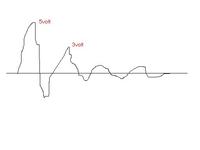capacitor1
Member level 3
Hi All,
In the attachment you may find the pulse waveform I would like to charge to a capacitor.

I have tried a bridge with a capacitor to store this pulse but it seems that only the energy ofhalf of the first positive pulse has been stored.Is there any way I could store all of its energy in the cap?
Regards,
Capacitor1
In the attachment you may find the pulse waveform I would like to charge to a capacitor.

I have tried a bridge with a capacitor to store this pulse but it seems that only the energy ofhalf of the first positive pulse has been stored.Is there any way I could store all of its energy in the cap?
Regards,
Capacitor1